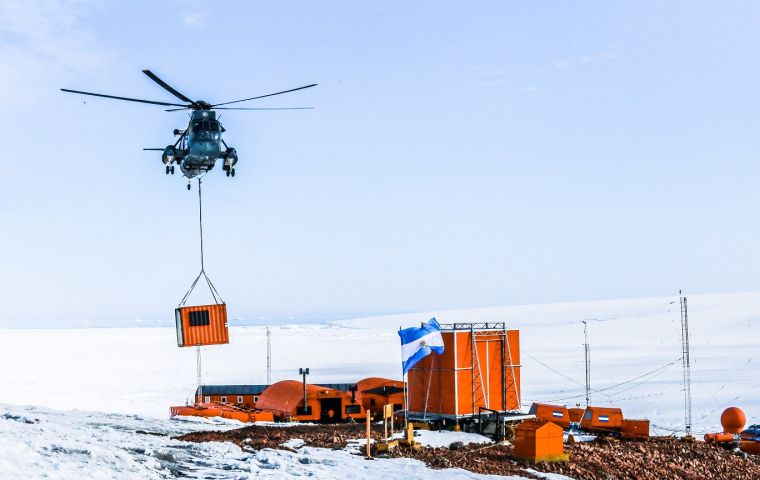MercoPress. South Atlantic News Agency
Argentina to set up Antarctica observatory to look for exoplanets
 The observatory will have a telescope with the instruments necessary to produce high-quality images, it was reported
The observatory will have a telescope with the instruments necessary to produce high-quality images, it was reported Argentina will install an observatory at the Belgrano II base in Antarctica, 1,300 kilometers from the South Pole, which will be operated from Buenos Aires. The automated telescope will be used to detect exoplanets and other celestial bodies which are difficult to watch from other latitudes, it was announced.
The “Argentine Antarctic Robotic Observatory” is a joint effort by the Argentine Antarctic Institute (IAA), the Institute of Astronomy and Space Physics (IAFE) and the National University of Hurlingham (Unahur). It will be aimed at making scientific observations of a photometric type on various objects in the night sky.
The observatory will have a telescope with the instruments necessary to produce high-quality images and an adequate infrastructure to house them in the face of extreme weather conditions. For that purpose, a dome was built with an automation system handled from the Unahur.
The facility is to be laid on a galvanized iron base, which is already installed on the Antarctic soil. IAFE researcher Mario Melita told Télam that “polar locations have important advantages for astronomy. In Antarctica there are regions where the climate is one of the most stable on the planet, with very little wind, low temperatures reduce the 'noise' in the detectors and, according to the latitude in which we stand, we can have six months by day and six months by night.”
Melita also highlighted the conditions of the new observatory to “study an astronomical phenomenon such as binary stars or exoplanets because constant data can be obtained over a long period of time and not observations of eight hours a day as can be done from positions further north.”
He added that “this project takes advantage of Argentina's logistical availability to operate from the Belgrano II Antarctic base, which is located just 17 degrees from the South Pole, from where the region of space visible from there can be monitored very regularly, something that stops the observatories located further north are more complex because their latitudes give them less access time”.
The physicist pointed out that ”this initiative not only seeks to advance in astronomical observation, but also to develop the necessary engineering to be able to set up an observatory that can operate in more isolated regions of Antarctica where it does not have a staff to provide technical support such as it happens at Belgrano II”.
“The observatory to be set up in Belgrano II is also a test model to see how this technology tolerates the weather conditions of that hostile environment, and in this particular location its
proximity to the coast,” Melita stressed.
“In the summer campaign of 2019-2020 the metallic structure that will serve as the base was assembled there, this summer the dome-shaped building that will protect the telescope will be moved to Belgrano II and next summer we will carry the telescope and the rest of the sensors,” Melita elaborated.
“The staff at Belgrano II will be responsible for the maintenance of the building and check if it is actually sufficiently watertight and robust, if the motors that must move the dome work and if the weatherstripping remain watertight under these climatic conditions,” Melita also pointed out.
The scientist also explained that ”the telescope itself is a piece of equipment donated to us by the Institute of Astronomical, Earth and Space Sciences (ICATE), a Conicet institute that does astronomy in San Juan, and during this year we are going to work to adapt the electronic components to the Antarctic cold and in the necessary systems so that in principle the observatory can be operated remotely from Buenos Aires, but with the aim that in the medium term it can function robotically, choosing which sectors to observe or when to do it based on the parameters programmed for each investigation”.
“We also hope to get the necessary knowledge for a future observatory that we plan totally autonomous, for which the main challenge still continues to be the provision of energy; In a continent where the vast majority of energy is generated with fossil fuels, we understand that to operate in a remote or isolated place where there may also be several months of night, we have to think [about] wind energy”, Melita added.
The researcher stressed that “as far as we know, this would be the third experience of this kind worldwide. China already has an observatory that allowed them to advance in various investigations and now plans to install another three or four similar ones in the short term, while also there is a telescope at the Concordia base that France and Italy operate jointly and it also proved to be very useful ”.
”This observatory will give us more opportunities to watch peculiar stars and exoplanetary systems, taking as a reference what we already know and the data provided by satellite missions, for example, the TESS mission. This location will allow us to produce data with a time base similar to that produced by satellites but with a much lower comparative cost”, Melita completed.
The Belgrano II Base is located in the Nunatak Bertrab, in Vahsel Bay on the Confín coast in the Land of Cotas, about 1,300 kilometers from the South Pole and about 5,000 from the city of Buenos Aires. At the international level, it is the southernmost on the mainland. The region is characterized by having four months of polar night and four months of day, in which temperatures can reach tens of degrees below zero with winds of up to 200 kilometers per hour.




Top Comments
Disclaimer & comment rulesCommenting for this story is now closed.
If you have a Facebook account, become a fan and comment on our Facebook Page!